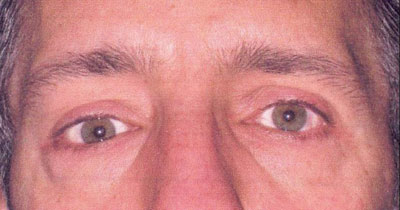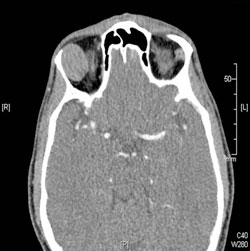Man presents for asymmetry in eye size, slow decline in vision
External examination showed inferior displacement of the right globe.
 Mark E. Patron |
 Andre J. Witkin |
A 47-year-old man presented to our oculoplastics clinic complaining that his right eye “looked smaller” than his left eye. He had noticed this asymmetry for at least 1 to 2 years and believed it had recently been getting worse. He also noted a slowly progressive decline in vision in the right eye for the past 2 years.
The patient had no significant medical history or ocular history. He was not on any medications. He worked as a financial analyst and denied any tobacco, alcohol or drug use.
Examination
On examination, the patient’s vision was 20/40 in the right eye with no improvement with refraction and 20/20 in the left. He did not have a relative afferent pupillary defect. IOPs were in the mid-teens in both eyes. Notably, he had some limitation of superotemporal gaze in the right eye (about 80% of normal), and the patient noted vertical diplopia in this direction. Hertel exophthalmometry revealed 2 mm of relative proptosis of the right eye.
|
Images: Batta P, Kapadia M |
External examination suggested inferior displacement of the right globe and slight narrowing of the right interpalpebral fissure (Figure 1). A firm, non-mobile, non-tender mass was palpable in the right superotemporal orbit, just below the lateral portion of the brow. Anterior and posterior segment examination was unremarkable in both eyes.

What is your diagnosis?
Mass in superotemporal orbit
The slowly progressive nature of this patient’s symptoms, along with the globe displacement and limitation of motility, is highly suggestive of an orbital tumor.
The most likely tumor in the superotemporal orbit is a lacrimal gland tumor. These are commonly divided into epithelial and lymphoproliferative processes. Epithelial tumors include the benign mixed tumor (also called pleomorphic adenoma), adenoid cystic carcinoma and, less commonly, malignant mixed tumor. Lymphoproliferative lesions include reactive hyperplasia, lymphoma and other inflammatory disorders. In this patient’s case, globe displacement and impaired motility make a lymphoproliferative lesion such as orbital lymphoma less likely. Lymphoma characteristically molds to the globe, without causing displacement, proptosis, motility limitation or double vision. On the other hand, epithelial tumors, especially the slow-growing pleomorphic adenomas, are known for causing globe displacement.
Other possibilities include cavernous hemangioma and meningioma. Cavernous hemangiomas typically cause slow, painless proptosis. Meningiomas can present in a variety of ways; if they infiltrate the orbit, they can cause proptosis, globe displacement, impaired motility and decreased vision.
|
|
|
|
Figure 2. A CT scan of the orbit with
contrast was performed in this patient, revealing a well-circumscribed,
homogeneous, minimally enhancing globular mass in the superotemporal right
orbit. |
|
A CT scan of the orbit with contrast was performed in this patient, revealing a well-circumscribed, homogeneous, minimally enhancing globular mass in the superotemporal right orbit (Figure 2).
Diagnosis
Given the clinical presentation and the appearance of the mass on CT imaging, the most likely diagnosis in this case is a pleomorphic adenoma. This benign neoplasm typically presents in middle-aged adults, more commonly in men. Slowly progressive, painless displacement of the globe inferiorly is a characteristic feature. Other common findings include axial proptosis, limitation of upward gaze and a palpable firm mass in the superotemporal orbit.
On radiographic imaging, a well-circumscribed round or oval mass is typically seen. Pleomorphic adenomas characteristically do not cause bone erosion, a feature that distinguishes them from the more destructive adenoid cystic carcinomas. However, long-standing pleomorphic adenomas can exhibit bony changes. Fossa formation, reactive sclerosis and bone erosion have all been seen in chronic adenomas.
It is important to differentiate pleomorphic adenoma from adenoid cystic carcinoma, a malignant tumor with a poor prognosis. The latter is more rapid in onset and seen in older patients. It is typically painful secondary to perineural invasion, and it is more likely than pleomorphic adenoma to display bone erosion on imaging.
Management
The standard of care for pleomorphic adenoma is a complete surgical excision of the tumor for diagnosis and treatment. An incomplete excision, a breach of the capsule or an incisional biopsy can all allow tumor spillage into the orbit, potentially leading to increased rates of tumor recurrence. Furthermore, recurrent pleomorphic adenoma carries increased risk of late malignant transformation. For these reasons, in cases in which pleomorphic adenoma is strongly suspected, complete excision without breach of capsule is ideal. However, this can be technically difficult and may require an extensive orbitotomy to allow for intact removal of the mass. Additionally, the rates of recurrence and malignant transformation, although higher with an incomplete excision, are still very low. Therefore, in cases in which the diagnosis is ambiguous, some more recent literature has suggested first performing an incisional biopsy to establish the diagnosis.
Follow-up
The patient underwent a lateral orbitotomy with excisional biopsy of the mass. The mass was removed completely and in one piece. Pathologic analysis revealed a 25-mm encapsulated mass with both ductal and stromal epithelium, consistent with a pleomorphic adenoma. On recent 3-month follow-up, the patient was doing well with no evidence of recurrence.
References:
- Bernardini FP, Bazzan M. Lymphoproliferative disease of the orbit. Curr Opin Ophthalmol. 2007;18(5):398-401.
- Bernardini FP, Devoto MH, Croxatto JO. Epithelial tumors of the lacrimal gland: an update. Curr Opin Ophthalmol. 2008;19(5):409-413.
- Currie ZI, Rose GE. Long-term risk of recurrence after intact excision of pleomorphic adenomas of the lacrimal gland. Arch Ophthalmol. 2007;125(12):1643-1646.
- Font RL, Gamel JW. Epithelial tumors of the lacrimal gland: an analysis of 265 cases. In: Jakobiec FA, ed. Ocular and Adnexal Tumors. Birmingham, AL: Aesculapius Publishers Inc.; 1978;787-805.
- Henderson JW, Garrity JA. Henderson’s Orbital Tumors. 4th ed. Lippincott Williams and Wilkins; 2007.
- Lai T, Prabhakaran VC, Malhotra R, Selva D. Pleomorphic adenoma of the lacrimal gland: is there a role for biopsy? Eye. 2009;23(1):2-6.
- Ni C, Cheng SC, Dryja TP, Cheng TY. Lacrimal gland tumors: a clinicopathological analysis of 160 cases. Int Ophthalmol Clin. 1982;22(1):99-120.
- Weis E, Rootman J, Joly TJ, et al. Epithelial lacrimal gland tumors: pathologic classification and current understanding. Arch Ophthalmol. 2009;127(8):1016-1028.
- Priti Batta, MD, and Mitesh Kapadia, MD, can be reached at New England Eye Center, Tufts University School of Medicine, 750 Washington St., Box 450, Boston, MA 02111; 617-636-4219; fax: 617-636-4866; Web site: www.neec.com.
- Edited by Mark E. Patron, MD, and Andre J. Witkin, MD. Drs. Patron and Witkin can be reached at New England Eye Center, Tufts University School of Medicine, 750 Washington St., Box 450, Boston, MA 02111; 617-636-4219; fax: 617-636-4866; Web site: www.neec.com.













